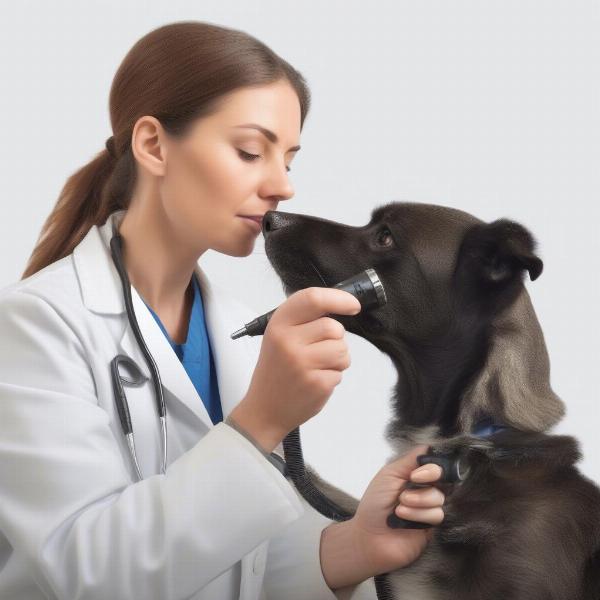An ear scope, also known as an otoscope, is a vital tool for veterinarians in diagnosing and treating ear problems in dogs. It provides a magnified view of the ear canal, allowing for a thorough examination of the eardrum and surrounding tissues. This article will delve into the importance of ear scoping, common ear issues diagnosed with it, and what to expect during the procedure.
 Dog Ear Examination with Otoscope
Dog Ear Examination with Otoscope
Why is Ear Scoping Important for Dogs?
Ear infections are prevalent among dogs, and an ear scope helps veterinarians accurately diagnose the underlying cause. Symptoms like scratching, head shaking, and ear discharge can indicate various issues, from simple inflammation to more serious conditions like ear mites or foreign bodies. Without proper visualization, treatment might be ineffective or even exacerbate the problem. Early and accurate diagnosis with an ear scope can prevent complications and ensure appropriate treatment. Furthermore, regular ear scoping can be beneficial for dogs prone to ear infections, allowing for early detection and intervention.
Common Ear Problems Diagnosed with an Ear Scope
Several ear conditions can be identified using an ear scope. These include:
- Otitis Externa: Inflammation of the outer ear canal, often caused by allergies, bacteria, or yeast.
- Otitis Media: Inflammation of the middle ear, typically a consequence of untreated otitis externa.
- Ear Mites: Tiny parasites that infest the ear canal, causing intense itching and inflammation.
- Foreign Bodies: Objects like grass seeds, dirt, or even small toys can lodge in the ear canal, causing irritation and infection.
- Ear Tumors: While less common, tumors can develop within the ear canal and are often detected through ear scoping.
What to Expect During an Ear Scoping Procedure
The ear scoping procedure is generally quick and non-invasive. The veterinarian will gently insert the otoscope into the dog’s ear canal, illuminating and magnifying the area. This allows them to visualize the eardrum, identify any abnormalities, and collect samples for further analysis if necessary (e.g., ear cytology). dog ear cytology Most dogs tolerate the procedure well, though some may experience mild discomfort. If the ear is significantly inflamed or painful, sedation may be necessary.
Ear Scoping for Puppies and Senior Dogs
Ear scoping is equally important for puppies and senior dogs. Puppies are particularly susceptible to ear mites and infections due to their developing immune systems. Regular ear checks can help prevent serious complications. Senior dogs can also experience age-related changes in their ear canals, making them more prone to infections. Routine ear scoping can help detect these issues early.
Conclusion
Ear scoping is a crucial diagnostic tool for identifying and treating ear problems in dogs. It allows veterinarians to visualize the ear canal, diagnose various conditions, and determine appropriate treatment strategies. Regular ear scoping can help prevent complications and ensure the long-term health of your dog’s ears. If you notice any signs of ear discomfort in your dog, such as scratching, head shaking, or discharge, consult your veterinarian for a professional examination.
FAQs
- Is ear scoping painful for dogs? Generally, ear scoping is not painful. Some dogs may experience mild discomfort, especially if the ear is inflamed.
- How often should my dog have their ears scoped? Discuss this with your veterinarian, as the frequency depends on your dog’s individual needs and predisposition to ear problems.
- Can I scope my dog’s ears at home? It’s best to leave ear scoping to a trained veterinarian to avoid causing injury or misdiagnosis.
- What should I do if my dog’s ears are red and itchy? Contact your veterinarian immediately for an examination and diagnosis.
- How are ear infections treated in dogs? Treatment varies depending on the underlying cause and may include ear drops, oral medications, or cleaning solutions.
- Can ear infections in dogs be prevented? Regular ear cleaning, managing allergies, and routine veterinary checks can help prevent ear infections.
- What are the signs of ear mites in dogs? Excessive scratching, head shaking, dark waxy debris, and a foul odor from the ears are common signs.
Related Articles:
About ILM Dog
ILM Dog is your trusted international resource for expert canine care and nurturing advice. We offer comprehensive guidance on various aspects of dog ownership, from breed selection and healthcare to training, nutrition, grooming, and more. Whether you’re a seasoned dog owner or just starting your journey, ILM Dog provides practical tips and valuable insights to help you provide the best possible care for your furry companion. Contact us at [email protected] or +44 20-3965-8624 for personalized support.